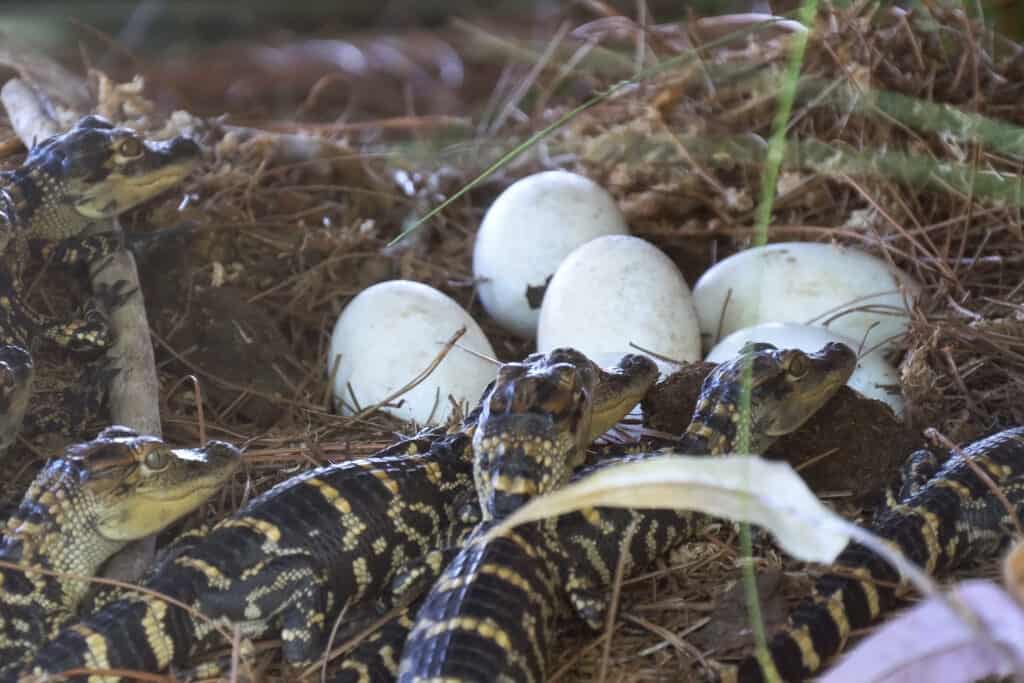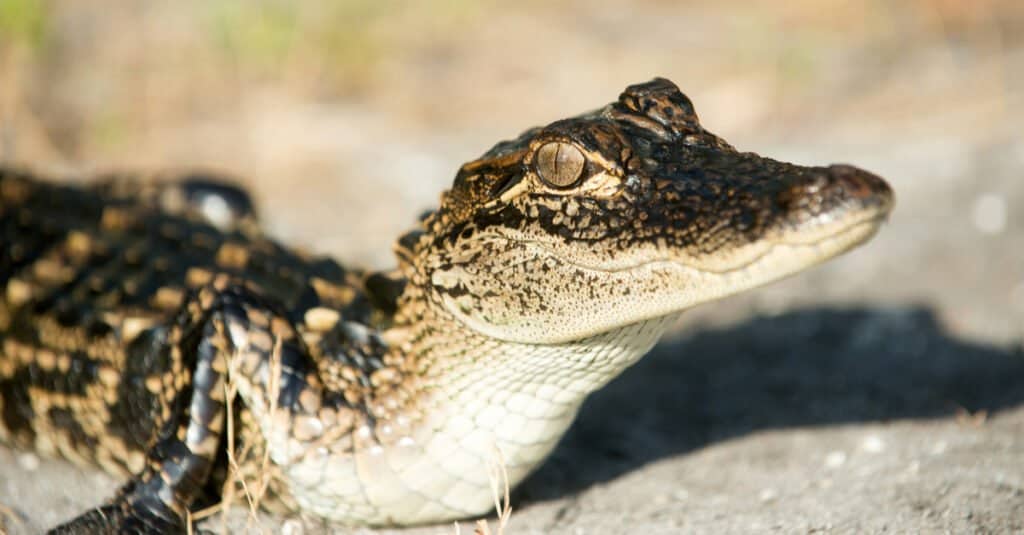Alligators are massive, roughly-scaled reptiles that everyone is terrified of. Their intimidating appearance enhances their menacing nature, and alligators are equipped with numerous teeth that show off even when their mouths are closed. Not to mention the alligator’s notoriously strong jaws that makes the alligator bite rank among the world’s strongest bite forces.
Generally, alligators are truly frightening, but it also can’t be denied that baby alligators, called hatchlings, are one of the cutest baby reptiles in the wild. Have you seen baby alligators riding their mommy’s back? If you haven’t, waste no time and pull up some pictures on the internet, you surely won’t be disappointed.
Considering the alligator’s intimidating stance and nature, it is difficult to imagine them around juveniles. Let alone think about them giving birth! This makes us wonder how alligators continue their lineage. Do alligators lay eggs or have live births? This article will explore the life of a baby alligator, how they are born, and other amazing facts.
Do Alligators Lay Eggs or Have Live Birth?
As reptiles, it is no surprise that alligators are oviparous, which means they lay eggs instead of giving live birth as mammals do. The American and Chinese alligators are the only two species of alligators still living today, and both species lay eggs and reproduce sexually.
American alligators are found in freshwater rivers, swamps, marshes, and lakes in the southeastern region of the United States. Alligators take around six months to mate and give birth; the young are usually born in the first few weeks of October.
Insects, small fish, snails, frogs, crabs, crayfish, and freshwater shrimp are among the foods that young alligators eat.
What Do Alligator Eggs Look Like?

Alligator eggs have a white shell covering and are slightly bigger than chicken eggs.
©Heiko Kiera/Shutterstock.com
Alligator eggs have a firm, white shell covering and are more oval and slightly bigger than a chicken egg. The eggshells are far more durable than chicken eggshells because they aim to safeguard the newborn alligators inside. The inner layer is soft, nevertheless; as a result, the egg has a somewhat snake-egg-like texture. It also doesn’t crack because the inner layer is supple like leather.
The egg’s outer covering becomes thinner as the embryo grows larger, letting the hard layer almost disappear by the time the gator hatches. It would have softened, and the hard layer would have nearly completely disappeared by the time the gator eventually hatches. This is to give way for the baby gators to crack away from their shells easily when the time comes.
The tip of the snout of baby alligators develops into a small, pointed projection that resembles a tooth known as the egg tooth. The egg tooth is struck against the interior of the eggshell when the baby gator is ready to hatch. Then the newborn alligator will depart from its egg when the shell splits. The egg tooth, an additional tooth for alligators, is lost by the time they reach adulthood.
Alligator eggs are being collected by a large number of people in wildlife and conservation parks. They artificially incubate the eggs to keep them away from predators.
Where Do Alligators Lay Eggs?
Alligators do not lay their eggs in water; rather, they do so on land. After mating, the female alligator will leave the water and search for a suitable location to construct an elevated nest for adequate drainage and protection from predators. Egg laying and nest construction take place at night. The female gator will start to arrange vegetation into a rounded mound once she has spotted a good location, and she will frequently make several attempts before settling on one. Some alligators will construct nests up to three feet tall, and some even have a six-foot diameter or more.
In most cases, this nesting activity lasts about two weeks. Although the time between copulation and egg-laying varies, it usually takes one to two months.
How Many Eggs Do Alligators Lay?

Alligators typically lay 20 to 50 eggs.
©DimaSid/Shutterstock.com
A mother alligator will lay between 20 and 50 eggs at the nest. She will then use foliage to conceal her eggs so they can hatch. Depending on the female’s age and condition, an alligator will lay a different amount of eggs. Larger, older females typically produce more eggs. Sadly, though, only less than 70% will survive because of predation.
Despite the alligators’ size and intimidating appearance, these reptiles are devoted parents. Female gators are aggressive moms, and they will faithfully guard their young from the moment she lays their eggs until they are juveniles.
Whether the eggs will develop into male or female depends on the temperature of the nesting area. Females are formed at temperatures between 82 and 86 degrees Fahrenheit, while between 90 and 93 degrees Fahrenheit is where males emerge. Mixed genders result from moderate temperatures between 82 and 90 degrees Fahrenheit.
How Long Do Baby Alligators Stay With Their Mothers?

Baby alligators remain under their mother’s care for close to a year.
©Tony Campbell/Shutterstock.com
For approximately a year, baby alligators remain under their mother’s care. When they are juveniles, they will join a pod, where they can remain for three years. For these reptiles, staying in a pod is a good defense, as it protects them from other predators. Alligators are susceptible to huge fish, raccoons, and raptors in their infancy. Male gators are known to prey on juvenile alligators, so they are also at risk from other alligators.
Alligator newborns are referred to as hatchlings, alligator mothers are referred to as cows, and a collection of mothers and babies is referred to as a pod. On the other hand, a mature male alligator is referred to as a bull. When they first hatch, hatchlings weigh about 56 grams and measure almost 10 inches. They typically cease growing at approximately 10 to 11 feet for females and 14 feet on average for males, gaining about a foot in length each year. Like their larger parents, these babies have a healthy appetite. Hatchlings, on the other hand, must consume smaller foods because of their size. Hatchlings eat insects like flies, snails, shrimp, and tiny fish as snacks.
The photo featured at the top of this post is © iStock.com/LagunaticPhoto
Thank you for reading! Have some feedback for us? Contact the AZ Animals editorial team.






